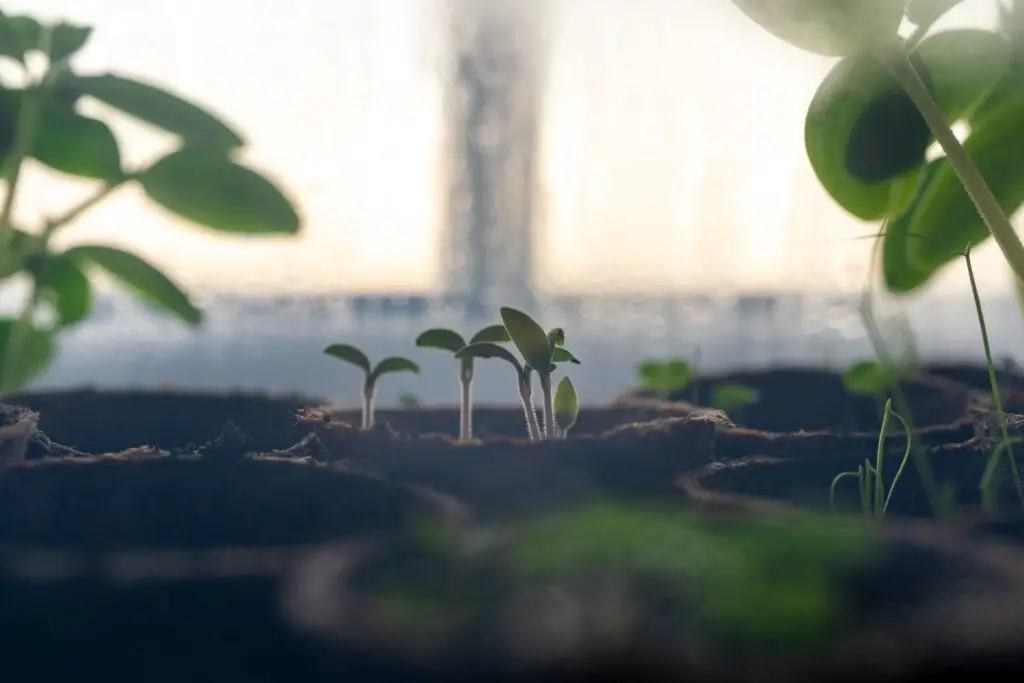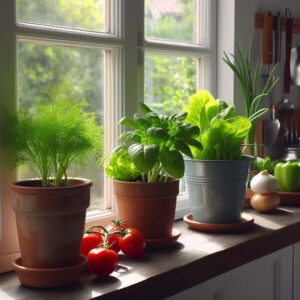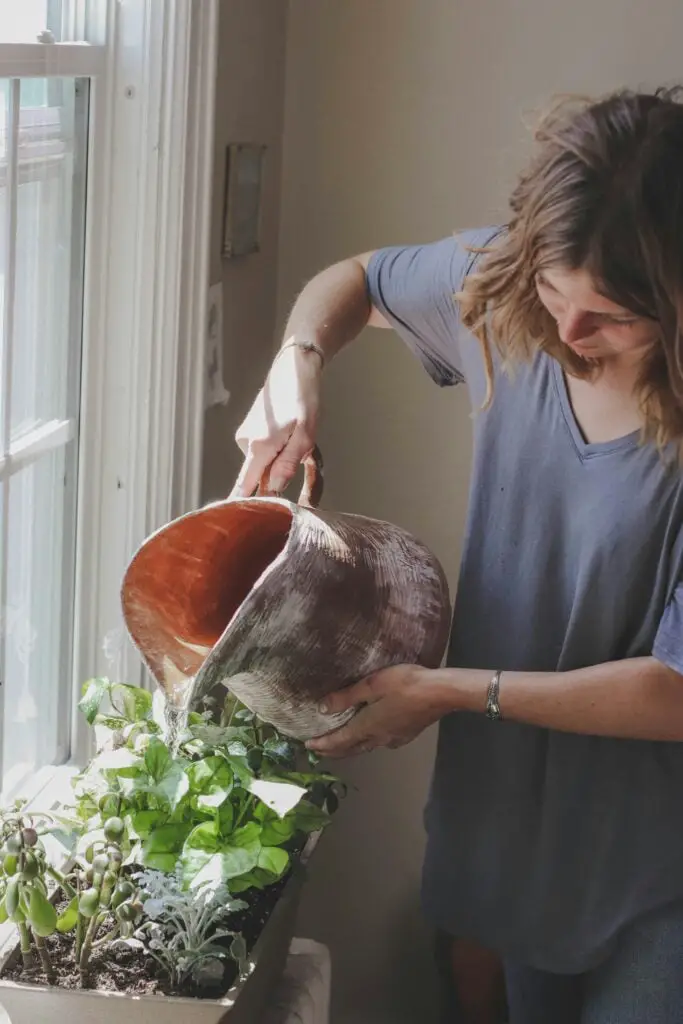Download: Best Vegetables to Grow on Your Windowsill and How To Grow Them
Table of Contents
Do you love fresh vegetables but don’t have a garden or a balcony? Don’t worry, you can still grow your own veggies indoors, on your windowsill. All you need is some pots, soil, seeds, and sunlight.
Growing vegetables on your windowsill is a fun, easy, and rewarding way to enjoy healthy food at home. Plus, you can save money on your grocery store bill, reduce waste, and add some greenery. I’d say that’s a win-win!
I’m sharing with you some of the best vegetables to grow on your windowsill and how to grow them. Whether you’re a beginner or an expert gardener, you’ll find something to suit your taste and skill level.
What Are the Best Vegetables to Grow on Your Windowsill?

Lettuce
Lettuce is one of the easiest and fastest vegetables to grow on your windowsill — a friend taught me how to do it in college. It can grow in shallow pots, and it can tolerate low light and cool temperatures. You can grow different varieties of lettuce, such as romaine, butterhead, leaf, or iceberg, and harvest them as baby greens or mature heads. No green thumb required!
To grow lettuce on your windowsill, you need to:
- Sow the seeds about 1/4 inch deep and 2 inches apart in a pot filled with moist potting mix.
- Place the pot on a sunny windowsill that gets at least 4 hours of light per day.
- Water the seeds lightly and keep the soil moist but not soggy.
- Thin the seedlings to 4 inches apart when they have two true leaves.
- Harvest the lettuce by cutting the outer leaves when they are 4 to 6 inches long, or the whole head when it is 6 to 8 inches in diameter.
Radish
Radish is another easy and fast vegetable to grow on your windowsill. It can grow in small pots, and it can tolerate low light and cool temperatures. You can grow different varieties of radish, such as cherry, French, or daikon, and harvest them as baby roots or mature roots.
To grow radish on your windowsill, you need to:
- Sow the seeds about 1/4 inch deep and 2 inches apart in a pot filled with moist potting mix.
- Place the pot on a sunny windowsill that gets at least 4 hours of light per day.
- Water the seeds lightly and keep the soil moist but not soggy.
- Thin the seedlings to 2 inches apart when they have two true leaves.
- Harvest the radish by pulling the roots when they are 1 to 2 inches in diameter.
Carrot
Carrot is a versatile and nutritious vegetable to grow on your windowsill. It can grow in deep pots, and it can tolerate low light and cool temperatures. You can grow different kinds of carrots, such as baby, finger, or rainbow, and harvest them as baby roots or mature roots.
To grow carrots on your windowsill, you need to:
- Sow the seeds about 1/4 inch deep and 2 inches apart in a pot filled with moist potting mix.
- Place the pot on a sunny windowsill that gets at least 4 hours of light per day.
- Water the seeds lightly and keep the soil moist but not soggy.
- Thin the seedlings to 2 inches apart when they have two true leaves.
- Harvest the carrot by pulling the roots when they are 1/2 to 1 inch in diameter.
Cherry Tomato
The cherry tomato is a delicious and colorful vegetable to grow on your windowsill. It can grow in large pots, and it needs high light and warm temperatures. You can grow different varieties of cherry tomatoes, such as red, yellow, or purple, and harvest them as clusters or individual fruits.
To grow cherry tomatoes on your windowsill, you need to:
- Plant a seedling or a cutting in a pot filled with moist potting mix.
- Place the pot on a sunny windowsill that gets at least 6 hours of light per day.
- Water the plant regularly and keep the soil moist but not soggy.
- Fertilize the plant with a diluted liquid organic fertilizer once every two weeks.
- Prune the plant by pinching off the suckers (the side shoots that grow between the main stem and the branches) to encourage more flowers and fruits.
- Support the plant with a stake or a cage to prevent it from falling over.
- Harvest the cherry tomato by picking the fruits when they are ripe and firm.

Hot Pepper
Hot pepper is a spicy and exotic vegetable to grow on your windowsill. It can grow in medium pots, and it needs high light and warm temperatures. You can grow different varieties of hot pepper, such as jalapeño, cayenne, or habanero, and harvest them as green or red fruits.
To grow hot pepper on your windowsill, you need to:
- Plant a seedling or a cutting in a pot filled with moist potting mix.
- Place the pot on a sunny windowsill that gets at least 6 hours of light per day.
- Water the plant regularly and keep the soil moist but not soggy.
- Fertilize the plant with a diluted liquid organic fertilizer once every two weeks.
- Prune the plant by removing any weak or overcrowded branches to allow for better air circulation and light exposure.
- Support the plant with a stake if necessary, to help it bear the weight of the fruits.
- Harvest the hot peppers by cutting them off the plant when they reach your desired size and color. They can be used green or left on the plant to ripen to red.
Cress
Cress, including varieties like plain cress and finely curled cress (Lepidium sativum), is one of the easiest vegetables to grow on a windowsill. It’s perfect for adding a peppery flavor to salads or sandwiches.
To grow cress:
- Line a tray with moist tissue or cotton wool, as compost is not necessary.
- Sprinkle cress seeds on top and press them lightly into the wet base.
- Place the tray on a sunny, warm windowsill and water gently daily, ensuring the tissue or cotton wool doesn’t dry out.
- Harvest the cress using scissors when shoots reach 3cm–5cm in height, typically within a week.
Pea Shoots
Pea shoots are a delightful addition to windowsill gardening, ideal for stir-fries and salads. You can use whole dried peas for this purpose.
To grow pea shoots:
- Soak dried peas in water overnight to activate them.
- Drain and spread the peas in a pot with a 3cm layer of compost, covering them with another 1cm layer of compost.
- Place the pot on a sunlit windowsill. They should sprout in a few days.
- Harvest when shoots are around six days old, before they become bitter.
- The pea shoots will regrow after cutting, providing a continuous supply of greens.
Herbs
Herbs like basil, parsley, and mint are high in vitamins and can transform simple dishes into flavorful meals. They are easy to grow and require minimal care.

To grow your own fresh herbs on a kitchen windowsill:
- Use a pot with drainage holes and fill it halfway with compost.
- Spread seeds about 3cm apart and cover them with a thin, 0.5cm layer of compost.
- Place on a sunny windowsill.
- Water every other day to keep the seeds moist.
- Harvest the herbs when they have around six leaves, but avoid harvesting all at once to allow continuous growth.
Chilies
Chilies are a vibrant and flavorful addition to your windowsill garden, perfect for spice enthusiasts.
How to grow chilies on your windowsill:
- Opt for compact varieties like Jalapeño or Serrano, suitable for small spaces.
- Use an 8-10 inch deep pot with drainage. Choose a well-draining, slightly acidic or neutral potting mix.
- Start with seeds, planting them ¼ inch deep. Keep the soil moist.
- Ensure they receive 6-8 hours of direct sunlight daily, ideally on a south-facing windowsill.
- Water when the topsoil feels dry. Avoid overwatering.
- Pick chilies when firm and fully colored.
Why Grow Vegetables on Your Windowsill?
- You can grow fresh, organic, and nutritious vegetables all year round, regardless of the season or the weather.
- You can control what goes into your food, avoiding pesticides, herbicides, and other chemicals that may harm your health and the environment.
- You can reduce your carbon footprint, as you don’t need to buy vegetables that are transported from far away, packaged in plastic, and stored in refrigerators.
- I do it to save money, as seeds and plants are cheaper than buying vegetables from the store or farmers’ market.
- We reduce food waste by harvesting only what we need and by using every part of the plant, from the roots to the leaves.
- You can enjoy the satisfaction of growing your own food, watching it grow, and eating it fresh from the source.
Can You Grow Vegetables on Windowsills During Winter Months?
Growing vegetables on a windowsill during the winter months is possible, but it comes with certain challenges and limitations. The success largely depends on the type of vegetable and the conditions you can provide. Here are some key points to consider:
- Light: Winter days are shorter and often cloudier, leading to less natural sunlight. Most vegetables require at least 6 hours of direct sunlight daily. You may need to supplement with grow lights to provide enough light for healthy growth.
- Temperature: Most vegetables prefer a consistent temperature range, typically above 60°F (15°C). Ensure your windowsill area doesn’t get too cold, especially at night. Avoid placing plants near drafty windows.
- Vegetable Selection: Choose vegetables that can tolerate lower light and cooler temperatures. Leafy greens like lettuce, spinach, and kale are more tolerant of winter conditions. Herbs like parsley, chives, and mint can also do well.
- Indoor Air Quality: Indoor heating can reduce humidity levels, which might not be ideal for some plants. Using a humidifier or misting the plants can help maintain adequate humidity.
- Care and Maintenance: Regularly check for pests, as indoor plants can still be susceptible to infestations. Also, be mindful of watering – indoor plants in winter might require less frequent watering than during warmer months.
- Microgreens: An alternative or addition to full-sized vegetables is growing microgreens. They require minimal space and grow quickly, making them ideal for winter windowsill gardening.
Conclusion: Best Vegetables for Your Kitchen Windowsill
Growing vegetables on your windowsill is a great way to enjoy fresh produce. It not only brings the joy of an indoor garden into your home but also contributes to a healthier lifestyle. With a bit of care and attention, you can harvest your own vegetables and fresh herbs, enhancing your meals with the freshest ingredients.
I hope this inspires you to start your own windowsill garden and enjoy the benefits of home-grown vegetables and herbs.
If you have any questions or tips of your own, feel free to leave a comment below. Now let’s all make some use of that sunny spot and small space!

